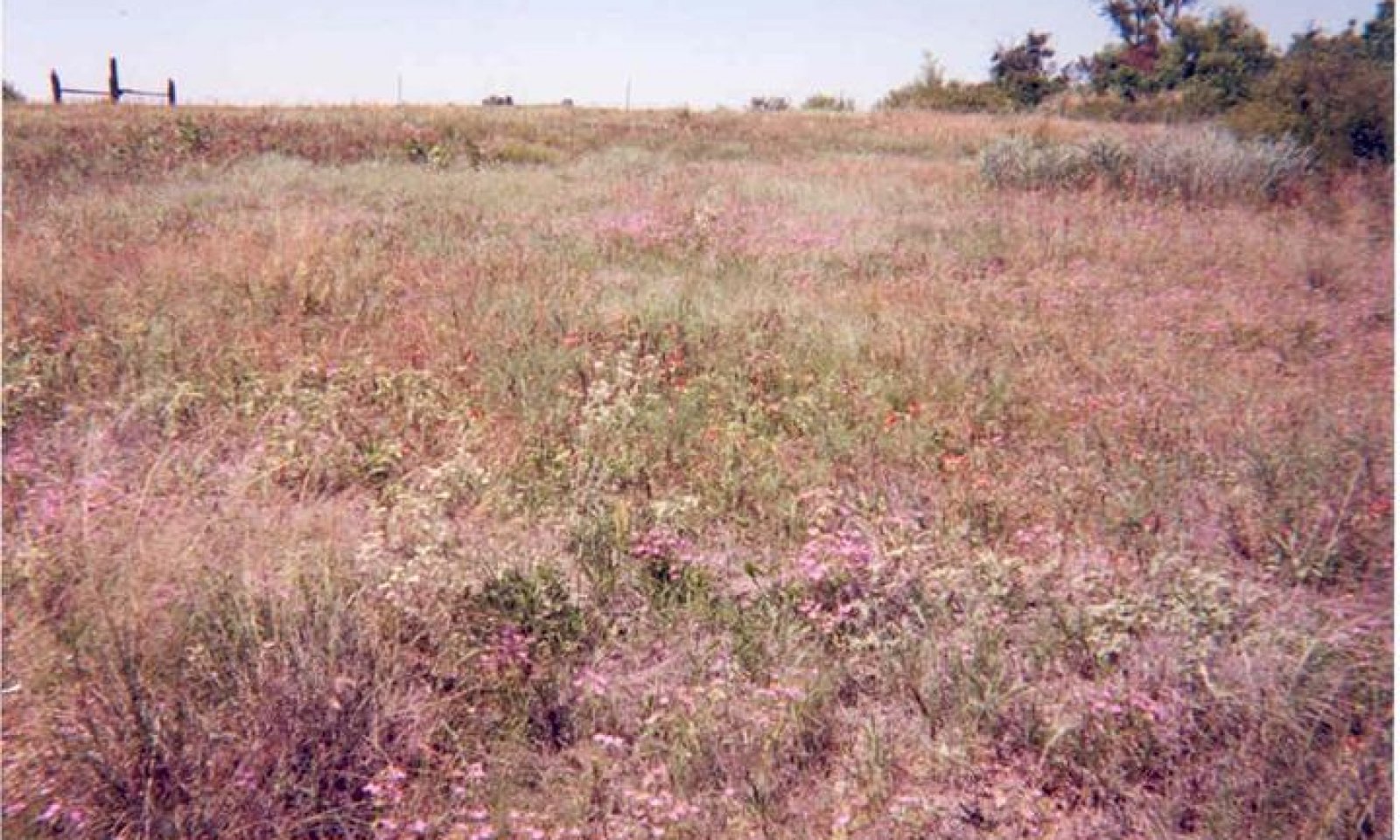

Natural Resources
Conservation Service
Ecological site R080AY091OK
Slickspot
Last updated: 9/19/2023
Accessed: 04/21/2025
General information
Provisional. A provisional ecological site description has undergone quality control and quality assurance review. It contains a working state and transition model and enough information to identify the ecological site.
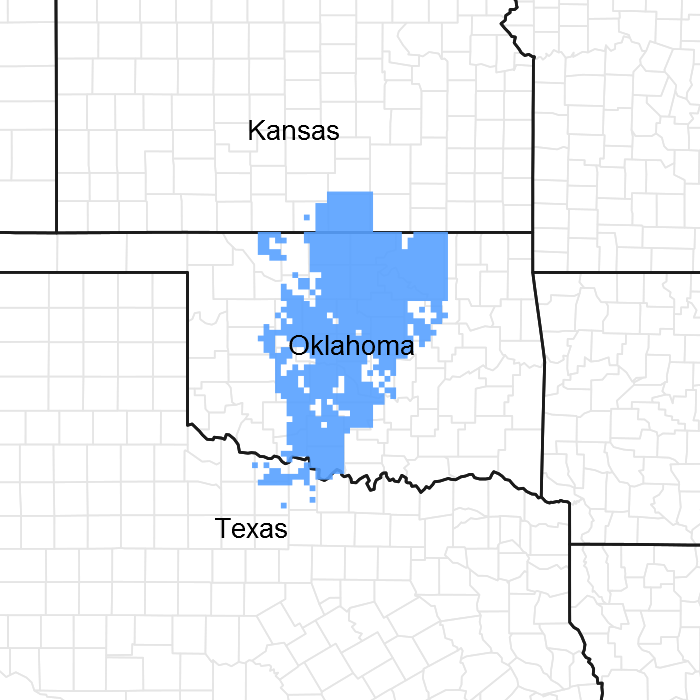
Figure 1. Mapped extent
Areas shown in blue indicate the maximum mapped extent of this ecological site. Other ecological sites likely occur within the highlighted areas. It is also possible for this ecological site to occur outside of highlighted areas if detailed soil survey has not been completed or recently updated.
MLRA notes
Major Land Resource Area (MLRA): 080A–Central Rolling Red Prairies
MLRA 80A is characterized by dark red Permian sandstones or shales that are exposed on gently sloping plains. The dominant soil order in this MLRA is Mollisols. The soils in the area dominantly have a thermic soil temperature regime, an ustic soil moisture regime, and mixed, siliceous, or smectitic mineralogy. They generally are shallow to very deep, are well drained, and generally are loamy or clayey. These plains are dissected by rivers that flow from northwest to southeast. Major rivers of this MLRA include the Chickaskia and Bluff rivers in KS, the Salt Fork, Cimarron, North and South Canadian, Washita, Cache, Red River in OK, and branches of the Wichita River in TX.
Classification relationships
This ecological site is correlated to soil components at the Major Land Resource Area (MLRA) level which is further described in USDA Ag Handbook 296.
Ecological site concept
The Slickspot ecosite occurs on depressed areas of lighter colored surface soils over compact clay layers. Salinity and sodicity is often high and surface crusting is common. These sites are commonly mapped as complexes within other soils/sites. Salt tolerant vegetation dominates these areas. Due to the nature of the soils, these areas may be particularly sensitive to erosion following soil disturbances.
Associated sites
| R080AY056OK |
Loamy Upland Loamy upland soils. No sodium issues. |
|---|
Similar sites
| R080AY097OK |
Saline Bottomland Bottomland sites with high salinity |
|---|---|
| R080AY001OK |
Alkali Bottomland Sodic areas on bottomlands |
Table 1. Dominant plant species
| Tree |
Not specified |
|---|---|
| Shrub |
Not specified |
| Herbaceous |
(1) Sporobolus airoides |
Physiographic features
The Slickspot site occurs on level to low slopes on hills and plains. Although slopes are relatively low, from 0 to 3 percent, the nature of the soils can result in accelerated runoff.
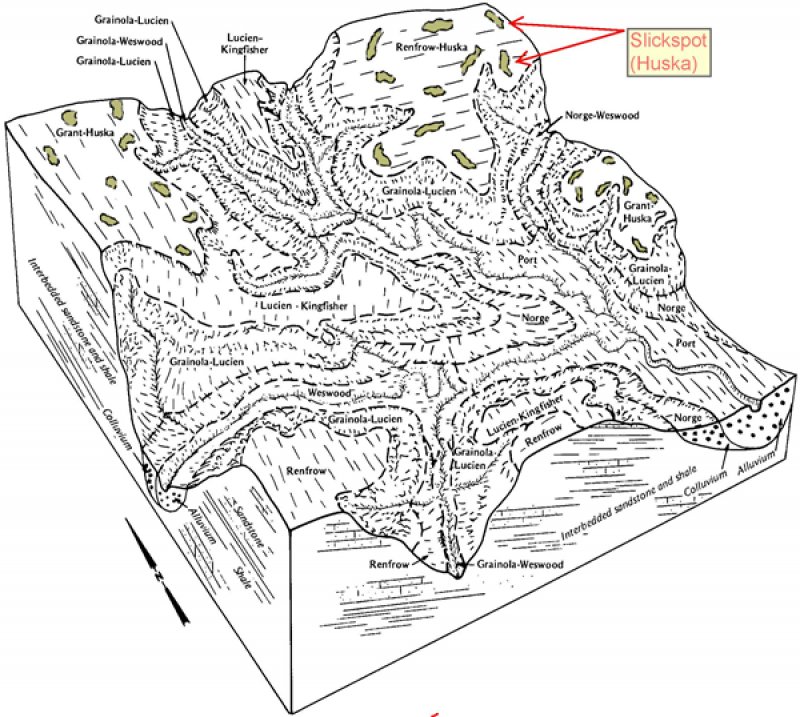
Figure 2. Slickspot
Table 2. Representative physiographic features
| Landforms |
(1)
Hills
> Hillslope
(2) Plains > Hillslope |
|---|---|
| Runoff class | High to very high |
| Elevation | 259 – 457 m |
| Slope | 0 – 3% |
| Aspect | Aspect is not a significant factor |
Climatic features
The climate is characterized by moist, cool, springs; hot, often dry summers; mild autumns; and mild to cold winters. Variation in timing and amounts of precipition from year to year is quite common. Drought cycles range from three to five years duration with occasionally longer periods occurring at unpredictable intervals. Above normal rainfall cycles are usually just as random, but shorter in duration.
Table 3. Representative climatic features
| Frost-free period (characteristic range) | 173-187 days |
|---|---|
| Freeze-free period (characteristic range) | 194-203 days |
| Precipitation total (characteristic range) | 838-940 mm |
| Frost-free period (actual range) | 157-192 days |
| Freeze-free period (actual range) | 191-208 days |
| Precipitation total (actual range) | 813-991 mm |
| Frost-free period (average) | 179 days |
| Freeze-free period (average) | 199 days |
| Precipitation total (average) | 889 mm |
Figure 3. Monthly precipitation range
Figure 4. Monthly minimum temperature range
Figure 5. Monthly maximum temperature range
Figure 6. Monthly average minimum and maximum temperature
Climate stations used
-
(1) WATONGA [USC00349364], Watonga, OK
-
(2) PAULS VALLEY 4 WSW [USC00346926], Pauls Valley, OK
-
(3) ANTHONY [USW00013980], Anthony, KS
-
(4) STILLWATER 5 WNW [USW00053927], Stillwater, OK
-
(5) OKEENE [USC00346629], Okeene, OK
-
(6) WALTERS [USC00349278], Walters, OK
-
(7) KINGFISHER [USC00344861], Kingfisher, OK
-
(8) JEFFERSON [USC00344573], Medford, OK
-
(9) CHEROKEE 4W [USC00341724], Cherokee, OK
Influencing water features
These sites occur in upland positions that are not subject to flooding or wetland influences.
Wetland description
N/A
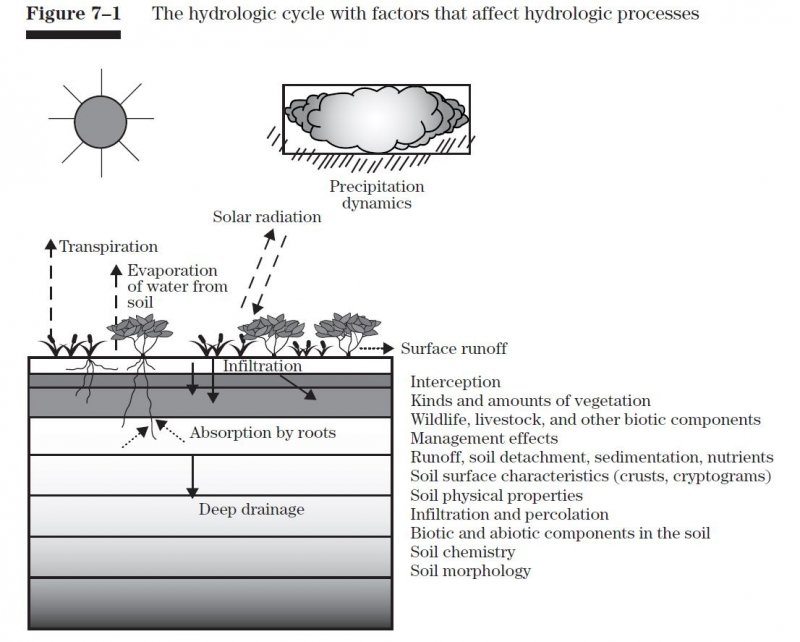
Figure 7.
Soil features
Soils are mapped for each county within the MLRA. Mapunits are representations of the major soil series component(s) and named accordingly. Each Mapunit is spatially represented on a digital soils map as polygons of different shapes and sizes. Within these Mapunits, there are often minor soil series components included. These minor components are soils that occur within a Mapunit polygon but are of small extent (15% or less of the Mapunit area). However, it is difficult to separate these minor soils spatially due to the scale of soil mapping.
Ecological sites are correlated at the component level of the soil survey. Therefore, a single Mapunit may contain multiple Ecological Sites just as it may contain multiple soil components. This is important to understand when investigating soils and Ecological Sites. A soil survey Mapunit may be correlated to a single Ecological Site based on the major component; however, there may be inclusional areas of additional Ecological Sites which are correlated to the minor components of that particular soil Mapunit.
Representative soil components for this site include:
Huska & Pawhuska
Slickspot soils occur in complexes. These sites are small depressed areas and usually light colored on the surface. Slickspots are easily recognized because of the contrast with adjacent ecological sites. Normally, the surface soil is 2 to 4 inches thick over compact clay. Infiltration is very slow and soil aeration is unfavorable for plant growth. Crusting restricts vegetative yields.

Figure 8. Huska
Table 4. Representative soil features
| Parent material |
(1)
Residuum
–
sandstone and shale
|
|---|---|
| Surface texture |
(1) Loam (2) Silt loam |
| Drainage class | Moderately well drained |
| Permeability class | Very slow to slow |
| Soil depth | 102 cm |
| Surface fragment cover <=3" | 0 – 2% |
| Surface fragment cover >3" | 0 – 2% |
| Available water capacity (0-101.6cm) |
7.62 – 20.32 cm |
| Electrical conductivity (0-101.6cm) |
3 – 10 mmhos/cm |
| Sodium adsorption ratio (0-101.6cm) |
10 – 20 |
| Soil reaction (1:1 water) (0-101.6cm) |
6 – 7.5 |
| Subsurface fragment volume <=3" (0-5.1cm) |
0 – 10% |
Ecological dynamics
Many sites across the Great Plains, including the Slickspot ecological site evolved with periodic disturbances such as wildfire, drought, and grazing(Frost 1998, Fuhlendorf 2009). The high sodium content makes vegetative growth difficult for most species. The compact clay soils and run-off upland position make the site susceptible to drought. However, the reference state of this site is resilient to natural disturbances. Due to the relatively small size of this site they are often mapped with other sites/soils.
Vegetation on this site can vary due to differences in salt content and the degree of compaction. Vegetation is primarily alkali sacaton, blue grama and buffalograss with various combinations and amounts of sideoats grama, windmillgrass, silver bluestem, tumblegrass, fall witchgrass, gummy lovegrass, and Texas grama (in the south). During extremely cool, wet spring years, prairie threeawn and western ragweed may increase above normal levels. Some Slickspots are so salty and droughty that vegetation will not grow while other Slickspot sites support diverse plant communities.
Historically, the focus of conservation efforts has been on restoring woody encroached sites across the Great Plains. However, new data suggests that a more effective strategy involves addressing woody plants in the seed dispersal stage prior to the change in ecological states. Preserving intact prairie for both agricultural production and ecosystem services must become a priority for land managers and conservationist alike.
State and Transition Diagram:
The following State and Transition Model suggests pathways vegetation might take depending on how ecological processes are changed. Local professional guidance should always be sought before pursuing a treatment scenario.
State and transition model
More interactive model formats are also available.
View Interactive Models
Click on state and transition labels to scroll to the respective text
Land use 1 submodel, ecosystem states
State 1 submodel, plant communities
Land use 2 submodel, ecosystem states
Land use 1
Rangeland
This land use is native rangeland. Dominant use is grazing by ruminant livestock.
State 1.1
Slickspot Grassland
This is the reference or diagnostic community for the site. The description is based on early range site descriptions, clipping data, professional consensus of experienced range specialists, and analysis of field work.
Dominant plant species
-
alkali sacaton (Sporobolus airoides), grass
-
blue grama (Bouteloua gracilis), grass
Community 1.1.1
Midgrass/Shortgrass, Alkali Sacaton Dominant

The Slickspot is a small area of open midgrass/shortgrass prairie with alkali sacaton being the dominant grass species and sideoats grama sometimes co-dominant on the site. The major shortgrasses are sideoats grama along with lesser amounts of blue grama and buffalograss. Slickspots can also support a variety of other grasses and forbs including sedges, common yarrow, windmillgrass, Scribner’s panicum, Texas grama, lovegrass species, silver bluestem, dropseeds, inland saltgrass, fall witchgrass, heath aster, tumblegrass, and paspalums. Prairie threeawn and western ragweed are common cyclic invaders. There can also be, especially in the southernmost counties of the state, a scattering of honey mesquite found on this site. The Slickspot reference plant community evolved via the influence of extremes in temperature, precipitation, wind, drought, fire and herbivory, especially bison herbivory. Slickspots are often small inclusions within larger Claypan and Loamy Upland ecological sites, so it is difficult to separate these small ecological sites into individual management units. On this site, grazing abuse tends to decrease alkali sacaton, sideoats grama and blue grama while increasing buffalograss, lovegrass, dropseed, inland saltgrass, tumblegrass, windmillgrass, and Texas grama. Also, under continuous abuse, reference plants will eventually be replaced by prairie threeawn and other annuals. This rate of replacement depends upon several factors including, but not limited to, stocking rate, time of grazing, and available moisture. Range management plans should include prescribed grazing and burning to restore, maintain, and manipulate the plant community towards the reference community, if desired. Short-term, early, heavy grazing on prairie threeawn to prevent seed production will aid in both the restoration and maintenance. Prescribed burning on heavy infestations of prairie threeawn and other targeted species will also aid in their control.
Figure 9. Annual production by plant type (representative values) or group (midpoint values)
Table 5. Annual production by plant type
| Plant type | Low (kg/hectare) |
Representative value (kg/hectare) |
High (kg/hectare) |
|---|---|---|---|
| Grass/Grasslike | 1065 | 2875 | 4046 |
| Forb | 45 | 121 | 170 |
| Shrub/Vine | 11 | 30 | 43 |
| Total | 1121 | 3026 | 4259 |
Figure 10. Plant community growth curve (percent production by month). OK0009, Native Warm-Season Grasses. The growing season for warm season(C4) grasses in this region runs from last frost to first frost with peak production from mid April through mid July. The curve listed below is intended to be a representative of normal growing conditions. The monthly production pecentages can vary from year to year deopending upon temperature and rainfall variatioins..
| Jan | Feb | Mar | Apr | May | Jun | Jul | Aug | Sep | Oct | Nov | Dec |
|---|---|---|---|---|---|---|---|---|---|---|---|
| J | F | M | A | M | J | J | A | S | O | N | D |
| 0 | 0 | 3 | 9 | 25 | 28 | 15 | 5 | 10 | 5 | 0 | 0 |
Community 1.1.2
Shortgrass, Blue Grama Dominant
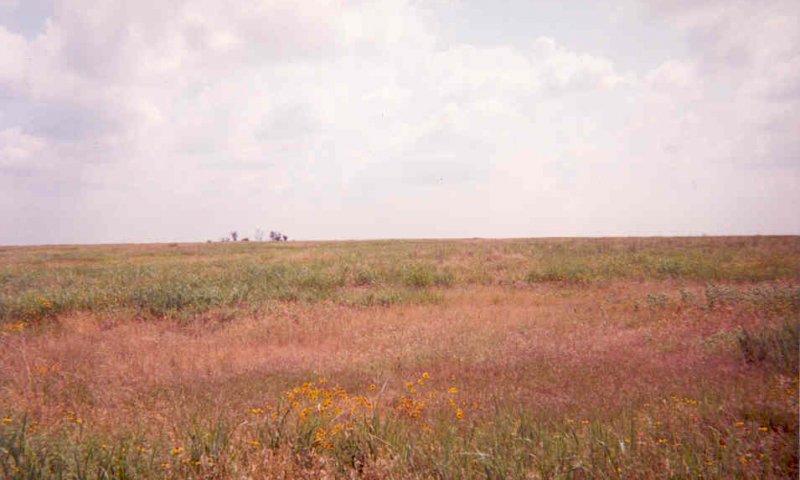
Figure 11. Blue Grama, Shortgrasses
This site is predominantly blue grama. Blue grama contributes 50% to 80% of the total non-woody annual vegetative production in this Slickspot stage. The balance of this site's vegetation is usually small percentages of other perennial grasses such as alkali sacaton, buffalograss, sideoats grama, meadow dropseed and gummy lovegrass. Abusive grazing is usually the prime contributor to the predominance of blue grama on this site. Blue grama proliferation will quicken as stocking rate increases. In years of dry summers followed by cool, mild, wet winters, prairie threeawn and western ragweed usually increase. Range management practices, including the use of prescribed grazing and burning, will help restore the plant community over time. Restoration to the reference community may take 10 years or more depending upon the condition of the site at the onset of restoration.
Figure 12. Plant community growth curve (percent production by month). OK0001, Native, Warm Season Grasses. Typically, the summer growing season for warm season grasses begins April 5 to 15 and ends October 15 to 25. Nearly three-fourths of the season production will occur before the first of July. This varies from year to year depending upon temperatures and precipitation..
| Jan | Feb | Mar | Apr | May | Jun | Jul | Aug | Sep | Oct | Nov | Dec |
|---|---|---|---|---|---|---|---|---|---|---|---|
| J | F | M | A | M | J | J | A | S | O | N | D |
| 0 | 1 | 5 | 10 | 20 | 30 | 10 | 5 | 10 | 6 | 2 | 1 |
Community 1.1.3
Threeawn Dominant
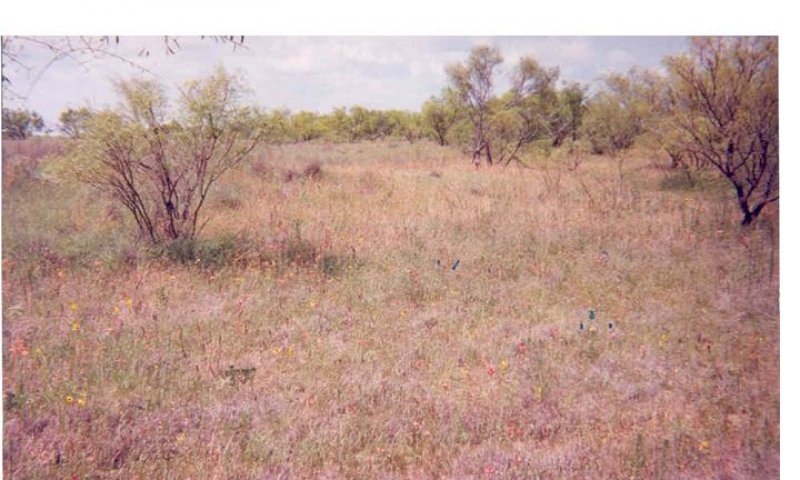
Figure 13. Slickspot, Disturbed
This site’s plant community is predominately prairie threeawn interspersed in remnants of perennial grasses such as alkali sacaton, blue grama, sideoats grama and buffalograss. This plant community is the result of long-term grazing abuse, a history of cultivation, or both. Numerous annuals are usually found on this site. In the southernmost areas of the state, honey mesquite may be found scattered about the site. Remnant perennial grasses will eventually respond to proper stocking rates, but it may take 15 years or more to do so depending upon site condition, seed bank, moisture availability, stocking rate, and other range management practices. In some cases, very few remnant grasses remain. When this occurs, the best management practice may be to reseed the site, however, overall benefits should probably be considered before any outside energy input is implemented.
Figure 14. Plant community growth curve (percent production by month). OK0002, Native Warm Season - North Oklahoma. This is the estimated growth curve for the northern half of Oklahoma where mean annual air temperatures are less than 60 degrees F. Plant growth can vary from year to year dependening on air temperature and timing and amount of precipitation. These figures are merely a representative example for warm season native plants in the geographic area..
| Jan | Feb | Mar | Apr | May | Jun | Jul | Aug | Sep | Oct | Nov | Dec |
|---|---|---|---|---|---|---|---|---|---|---|---|
| J | F | M | A | M | J | J | A | S | O | N | D |
| 0 | 0 | 3 | 15 | 20 | 30 | 10 | 6 | 10 | 6 | 0 | 0 |
Pathway 1.1A
Community 1.1.1 to 1.1.2


If abusive grazing practices persist, the community may shift towards 1.2 as the less palatable species are able to dominate.
Pathway 1.2A
Community 1.1.2 to 1.1.1


With the implementation of a prescribed grazing system that includes growing season deferment, the community may shift towards the reference community 1.1.
Pathway 1.2B
Community 1.1.2 to 1.1.3


If abusive grazing practices persist, the community may shift towards 1.2 as the less palatable species are able to dominate.
Pathway 1.3A
Community 1.1.3 to 1.1.2


With the implementation of a prescribed grazing system that includes growing season deferment for multiple years, the community may begin to shift towards community 1.2. This could take several years of favorable precipitation to occur.
State 1.2
Go back/Reseeded
This state represents the return of native species after the cessation of cultivation and cropping. The sites are sometimes reseeded or often let "go back" to naturally revegetate in perennial grasses.
Characteristics and indicators. While many native species may persist in this state, the soil structure and biology are still altered from the past cultivation. Species establishment, production, and vigor may be quite variable from site to site.
Resilience management. Once perennial vegetation is re-established. The soil cover and rootstocks should help stabilize the site and increase resiliency. However, the biological and structural damage from cultivation will take a very long time to recover.
Dominant plant species
-
alkali sacaton (Sporobolus airoides), grass
State 1.3
Eroded
This state is the result of water erosion over bare soil. Most of the "A" horizon of the soil profile has been displaced. The remaining subsoil is very low in fertility. Some native grasses and forbs will persist in this state, however, production is greatly reduced.
Dominant plant species
-
threeawn (Aristida), grass
Transition T1A
State 1.1 to 1.2
With cultivation and seeding, this site has been altered and has transitioned to an alternative ecological state. The soil properties have been altered significantly.
Restoration pathway R3A
State 1.2 to 1.1
This restoration pathways is not certain. Possibility of returning to the reference state depends on many factors including length of time in cultivation, remaining soil resources, restoration methods, and others. Contact local NRCS office for site specific recommendations.
Transition T2A
State 1.2 to 1.3
This state is the result of water erosion over bare soil. Most of the "A" horizon of the soil profile has been displaced. The remaining subsoil is very low in fertility. Some native grasses and forbs will persist in this state, however, production is greatly reduced.
Land use 2
Pastureland
The site has been replanted to introduced forage grasses after cultivation ceased. Primary use is livestock and/or hay production. Often, this land use is managed as a monoculture with little biotic diversity. However, in some cases, forb/legume/grass mixtures are maintained with may increase soil and ecosystem health.
State 2.1
Introduced Monoculture
This community consists of a planted monoculture of an introduced pasture grass used predominately for grazing and/or hay production. Adapted species include bermudagrass, old world bluestems, and weeping lovegrass (only on well drained sites). These species require a higher level of management inputs than native rangeland species. Soil tests should be performed prior to planting and or subsequent fertilizer applications. Without persistent nutrient management and proper grazing, some undesired "weedy" species may invade the site. While biodiversity can be beneficial to both plants, animals, and soil, it may be undesirable under certain management systems such as certified hay production. Proper grazing should be planned to allow for adequate residual heights in order to ensure the vigor of the grass. These heights vary by species and grazing system. They can be found in the OK NRCS Prescribed Grazing practice specification. Average yields are listed below as representative for the MLRA. These yields can vary greatly depending on precipitation amount and timing. As with any pasture management program, site specific evaluation and monitoring is essential. It is important to note that while these introduced species can provide good grazing potential, often wildlife habitat is limited. These species are also known to expand offsite and become invasive in adjacent native ecosystems.
Dominant plant species
-
Bermudagrass (Cynodon dactylon), grass
State 2.2
Grass/Legume Mix
This community represents a planted mixture of introduced grasses and forbs/legumes. Bermudagrass and introduced clover is the most common pasture mix. Incorporation of a legume into the system can help offset inputs associated with nitrogen additions. Special strategies should be used to ensure the health and vigor of both the cool season legumes and warm season grasses. Yields for these pasture mixes are not available as the mixtures and ratios vary from site to site so yields for a monoculture community should be used as a baseline estimate.
Dominant plant species
-
Bermudagrass (Cynodon dactylon), grass
-
clover (Trifolium), other herbaceous
Land use 3
Cropland
This land use is cultivated or prior cultivated cropland that is still in production of commodity crops.
Conversion C1
Land use 1 to 3
Through cultivation and seeding of crop species, this land use is converted to Cropland.
Conversion C3
Land use 2 to 1
This land use conversion is achieved through reseeding native grasses and forbs or allowing native species to repopulate the site by reducing management of introduced species. While the site may be converted back to a rangeland land use, some soil properties and ecological function may not return to pre-cultivation levels.
Conversion C4
Land use 3 to 1
This land use conversion is achieved through reseeding native grasses and forbs in order to restore the site for livestock grazing or hay production. While the site may be converted back to a rangeland land use, some soil properties and ecological function may not return to pre-cultivation levels.
Conversion C2
Land use 3 to 2
With the cessation of cultivation and planting of perennial introduced forage grasses, this land use is converted to Introduced Pastureland.
Additional community tables
Table 6. Community 1.1 plant community composition
| Group | Common name | Symbol | Scientific name | Annual production (kg/hectare) | Foliar cover (%) | |
|---|---|---|---|---|---|---|
|
Grass/Grasslike
|
||||||
| 1 | 953–2074 | |||||
| alkali sacaton | SPAI | Sporobolus airoides | 336–1277 | – | ||
| sideoats grama | BOCU | Bouteloua curtipendula | 112–426 | – | ||
| blue grama | BOGR2 | Bouteloua gracilis | 112–426 | – | ||
| buffalograss | BODA2 | Bouteloua dactyloides | 112–426 | – | ||
| 2 | 381–1448 | |||||
| lovegrass | ERAGR | Eragrostis | 56–213 | – | ||
| silver beardgrass | BOLA2 | Bothriochloa laguroides | 56–213 | – | ||
| tumble windmill grass | CHVE2 | Chloris verticillata | 56–213 | – | ||
| witchgrass | PACA6 | Panicum capillare | 56–213 | – | ||
| field paspalum | PALA10 | Paspalum laeve | 56–213 | – | ||
| tumblegrass | SCPA | Schedonnardus paniculatus | 56–213 | – | ||
| saltgrass | DISP | Distichlis spicata | 11–43 | – | ||
| Texas grama | BORI | Bouteloua rigidiseta | 11–43 | – | ||
| Scribner's rosette grass | DIOLS | Dichanthelium oligosanthes var. scribnerianum | 11–43 | – | ||
| 3 | 123–469 | |||||
| prairie threeawn | AROL | Aristida oligantha | 45–170 | – | ||
| sedge | CAREX | Carex | 45–170 | – | ||
| purple threeawn | ARPUP6 | Aristida purpurea var. purpurea | 11–43 | – | ||
|
Forb
|
||||||
| 4 | 45–170 | |||||
| common yarrow | ACMI2 | Achillea millefolium | 45–170 | – | ||
| Cuman ragweed | AMPS | Ambrosia psilostachya | 45–170 | – | ||
| yellowspine thistle | CIOC2 | Cirsium ochrocentrum | 45–170 | – | ||
| Texas croton | CRTE4 | Croton texensis | 45–170 | – | ||
| dotted blazing star | LIPU | Liatris punctata | 45–170 | – | ||
| white heath aster | SYER | Symphyotrichum ericoides | 11–45 | – | ||
|
Shrub/Vine
|
||||||
| 5 | 11–43 | |||||
| pricklypear | OPUNT | Opuntia | 11–43 | – | ||
Interpretations
Animal community
This site may have some value to certain wildlife species, however, since they are quite small in scale, habitat quality is dependent on adjacent areas. These areas are usually dominated by species of low grazing value for cattle operations.
Hydrological functions
The Slickspot ecological site gets its name from the fact that it appears to be very dry on the surface, but because it has a compacted clay loam subsoil and permeability class of impermeable to slow, it is usually boggy (slick) just below the surface. Many farmers and ranchers have mistakenly rode, plowed, walked, or driven across one of these areas only to become stuck; hence the name, Slickspot.
Infiltration can be very low in the subsurface. Run off is common. Due to the high sodium content, the soils may be dispersive and susceptible to erosion if vegetative cover is removed.
Recreational uses
N/A
Wood products
N/A
Other products
N/A
Other information
N/A
Supporting information
Inventory data references
Data Source: Clipping Data
Number of Records: 15
Sample Period: 10/59 – 12/70
State: OK
County: Jefferson
SCS Range – 417 clipping records
These records are filed at the Stillwater, OK State Office and should be available as vegplot data in NASIS.
Type locality
| Location 1: Jefferson County, OK |
|---|
References
-
Frost, C.C. 1998. Presettlement Fire Frequency Regimes of the United States: A First Approximation. Plant Conservation Program. North Carolina Department of Agriculture and Consumer Services, Raleigh, NC.
-
Fuhlendorf, S.D., D.M. Engle, J. Kerby, and R. Hamilton. 2009. Pyric Herbivory: Rewilding Landscapes through the Recoupling of Fire and Grazing. Conservation Biology 23:588–598.
Other references
Bestelmeyer, B. T., Brown, J. R., Havstad, K. M., Alexander, R., Chavez, G., & Herrick, J. E. (2003). Development and use of state-and-transition models for rangelands. Journal of Range Management, 114-126.
Harlan, J. R. (1957). Grasslands of Oklahoma.
National Soil Information System (NASIS). Accessed 2013
Shantz, H. L. (1923). The natural vegetation of the Great Plains region. Annals of the Association of American Geographers, 13(2), 81-107.
Shiflet, T. N. (1994). Rangeland cover types of the United States (Vol. 152). Denver, CO, USA: Society for Range Management.
Technical Editors:
Mark Moseley, State Range Conservationist, NRCS
Harry Fritzler, Range Conservationist, NRCS
Dr. Jack Eckroat, Grazing Lands Specialist, NRCS
Contributors
Dr. Jack Eckroat, Grazing Lands Specialist, NRCS, Oklahoma
John O. Pewthers, SCS, Oklahoma, (Retired)
Edits by Colin Walden, Soil Survey, Stillwater, OK
Approval
Bryan Christensen, 9/19/2023
Acknowledgments
Site Development and Testing Plan
Future work, as described in a Project Plan, to validate the information in this Provisional Ecological Site Description is needed. This will include field activities to collect low, medium and high intensity sampling, soil correlations, and analysis of that data. Annual field reviews should be done by soil scientists and vegetation specialists. A final field review, peer review, quality control, and quality assurance reviews of the ESD will be needed to produce the final document. Annual reviews of the Project Plan are to be conducted by the Ecological Site Technical Team.
Rangeland health reference sheet
Interpreting Indicators of Rangeland Health is a qualitative assessment protocol used to determine ecosystem condition based on benchmark characteristics described in the Reference Sheet. A suite of 17 (or more) indicators are typically considered in an assessment. The ecological site(s) representative of an assessment location must be known prior to applying the protocol and must be verified based on soils and climate. Current plant community cannot be used to identify the ecological site.
| Author(s)/participant(s) | Harry Fritzler, Steve Glasgow, Jack Eckroat, Mark Moseley |
|---|---|
| Contact for lead author | |
| Date | 07/01/2005 |
| Approved by | Colin Walden |
| Approval date | |
| Composition (Indicators 10 and 12) based on | Annual Production |
Indicators
-
Number and extent of rills:
Due to flatter slopes, there are usually few, if any, rills and there is no active headcutting and sides are covered with vegetation. -
Presence of water flow patterns:
There is some distinct evidence of soil deposition or erosion, (typically around bunchgrasses); otherwise water generally flows evenly over the entire landscape. -
Number and height of erosional pedestals or terracettes:
Pedestals are rare, usually not more than 1 inch deep (usually around rocks and bunchgrasses). Terracettes are absent . -
Bare ground from Ecological Site Description or other studies (rock, litter, lichen, moss, plant canopy are not bare ground):
These sites are complexes comprised of Loamy Prairie and Claypan Prairie soils with slickspots occupying 10-30% of the area. There should generally be ~10% bare ground. In the more saline portions, bare ground varies due to sodium content, but may be as much as 30%. -
Number of gullies and erosion associated with gullies:
Rare, due to flatter slopes and sodium content. -
Extent of wind scoured, blowouts and/or depositional areas:
None. -
Amount of litter movement (describe size and distance expected to travel):
Distribution of litter is variable due to sodium content. If the amount of bare ground is high, then litter movement will be greater. On the average, litter can move ~12-18 inches, then only during high intensity storms. -
Soil surface (top few mm) resistance to erosion (stability values are averages - most sites will show a range of values):
Surface soil is stabilized (Stability Score 5-6). Stability scores based on a minimum of 6 samples tested. -
Soil surface structure and SOM content (include type of structure and A-horizon color and thickness):
A horizon: 0 to 6 inches; brown silt loam, hard and friable with a very abrupt boundary. B horizon: 6 to 50 inches; reddish brown silty clay to yellowish red to red clay, columnar structure to blocky structure, very hard and firm.
Refer to specific description for component sampled. -
Effect of community phase composition (relative proportion of different functional groups) and spatial distribution on infiltration and runoff:
Infiltration capacity of this soil is naturally low and runoff is very high. The plant community composition and distribution is a Midgrass and Shortgrass community randomly dispersed. Slowly permeable soils result in high runoff. M -
Presence and thickness of compaction layer (usually none; describe soil profile features which may be mistaken for compaction on this site):
There is usually no compaction layer. Fine texture and hard, firm structure can be mistaken for a compaction layer, but this is a natural characteristic. -
Functional/Structural Groups (list in order of descending dominance by above-ground annual-production or live foliar cover using symbols: >>, >, = to indicate much greater than, greater than, and equal to):
Dominant:
Midgrasses ShortgrassesSub-dominant:
ForbsOther:
Shrubs AnnualsAdditional:
-
Amount of plant mortality and decadence (include which functional groups are expected to show mortality or decadence):
Plant mortality and decadence is highly variable on this site due to the droughty nature of the clayey soils, (especially after a severe drought), but will primarily average ~5-10%, especially in the absence of fire and herbivory. -
Average percent litter cover (%) and depth ( in):
Litter should cover ~60% of the area between plants with accumulations of up to 1/2 inch deep. -
Expected annual annual-production (this is TOTAL above-ground annual-production, not just forage annual-production):
Normal production is 1000 – 3800 pounds per year. -
Potential invasive (including noxious) species (native and non-native). List species which BOTH characterize degraded states and have the potential to become a dominant or co-dominant species on the ecological site if their future establishment and growth is not actively controlled by management interventions. Species that become dominant for only one to several years (e.g., short-term response to drought or wildfire) are not invasive plants. Note that unlike other indicators, we are describing what is NOT expected in the reference state for the ecological site:
No invasive species. Invasives might include: mesquite, prickly pear, annuals and non-natives. -
Perennial plant reproductive capability:
All plants capable of reproducing at least every 2 years. Seed stalks, stalk length, and seedheads are numerous and what would be expected. Overall health of plants is what would be expected.
Print Options
Sections
Font
Other
The Ecosystem Dynamics Interpretive Tool is an information system framework developed by the USDA-ARS Jornada Experimental Range, USDA Natural Resources Conservation Service, and New Mexico State University.
Click on box and path labels to scroll to the respective text.